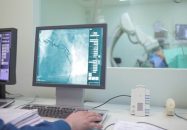The presence of calcification in coronary arteries (CAC) remains a challenge for the percutaneous treatment of these lesions. Several studies have established the link between CAC and poor long term results. Intravascular lithotripsy (IVL) has surged as a tool to induce calcified plaque fracture. Even though studies on this strategy are not randomized, they have…
New Devices for Percutaneous Treatment of Native Aortic Regurgitation: Expanding Horizons
Severe aortic regurgitation (AR) may account for 20% to 30% of all surgical aortic valve replacements (SAVR) and is often associated with aortic stenosis (AS). Transcatheter treatment of these patients is limited due to anatomical factors such as root and annular dilation, large annular dimensions, and less calcification in the valve leaflets to serve as…
SOLACI PERIPHERAL | 7th Clinical Case: Percutaneous Treatment for Nutcracker Syndrome
New SOLACI PERIPHERAL clinical case to keep learning among peers! Dr. Carlos Eduardo Díniz Couto shares a “Nutcracker” case from Belo Horizonte, Brazil. This is the 7th clinical case presented by SOLACI Peripheral on the SOLACI website. This space is intended to further promote and share experiences and opinions in order to continue improving our…
Good Outcomes for MitraClip “Off Label”
Courtesy of Dr. Carlos Fava. Mitral regurgitation is the most frequent type of valve disease, accounting for >6% of patients over 65 years old. Surgery is currently the strategy of choice, but percutaneous treatment is a valid alternative. The long-term progress of symptomatic patients at high surgical risk who do not meet the formal indications for…
Surgical or Percutaneous Management of Mitral Leak
Mitral paravalvular leaks are relatively common after surgical mitral replacement, with an incidence of 7%-17%. Most of these are subclinical leaks, a mere echocardiogram finding, but about 3% of patients can develop heart failure, hemolysis, or a combination of both, thus requiring a new intervention. For symptomatic patients, new surgery has been the traditional treatment…
Is it safe to perform percutaneous treatment in acute pulmonary thrombosis?
Courtesy of Dr. Carlos Fava Massive and submassive pulmonary embolism (PE) has traditionally been treated with anticoagulation and catheter direct thrombolysis (CDT), but the safety and efficacy of this treatment has not been yet properly assessed. The study analyzed 137 patients presenting acute PE massive or submassive. All patients received CTD associated to heparin…





